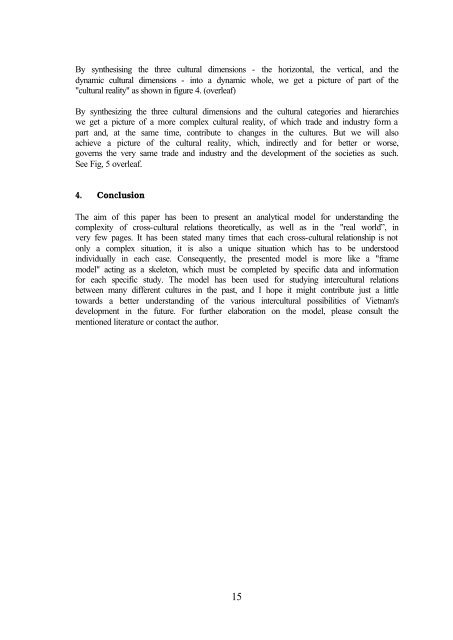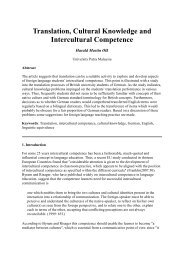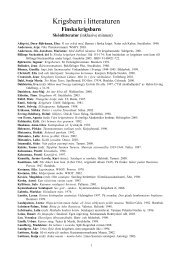the complexity of intercultural communication in cross-cultural
the complexity of intercultural communication in cross-cultural
the complexity of intercultural communication in cross-cultural
You also want an ePaper? Increase the reach of your titles
YUMPU automatically turns print PDFs into web optimized ePapers that Google loves.
By syn<strong>the</strong>sis<strong>in</strong>g <strong>the</strong> three <strong>cultural</strong> dimensions - <strong>the</strong> horizontal, <strong>the</strong> vertical, and <strong>the</strong><br />
dynamic <strong>cultural</strong> dimensions - <strong>in</strong>to a dynamic whole, we get a picture <strong>of</strong> part <strong>of</strong> <strong>the</strong><br />
"<strong>cultural</strong> reality" as shown <strong>in</strong> figure 4. (overleaf)<br />
By syn<strong>the</strong>siz<strong>in</strong>g <strong>the</strong> three <strong>cultural</strong> dimensions and <strong>the</strong> <strong>cultural</strong> categories and hierarchies<br />
we get a picture <strong>of</strong> a more complex <strong>cultural</strong> reality, <strong>of</strong> which trade and <strong>in</strong>dustry form a<br />
part and, at <strong>the</strong> same time, contribute to changes <strong>in</strong> <strong>the</strong> cultures. But we will also<br />
achieve a picture <strong>of</strong> <strong>the</strong> <strong>cultural</strong> reality, which, <strong>in</strong>directly and for better or worse,<br />
governs <strong>the</strong> very same trade and <strong>in</strong>dustry and <strong>the</strong> development <strong>of</strong> <strong>the</strong> societies as such.<br />
See Fig, 5 overleaf.<br />
4. Conclusion<br />
The aim <strong>of</strong> this paper has been to present an analytical model for understand<strong>in</strong>g <strong>the</strong><br />
<strong>complexity</strong> <strong>of</strong> <strong>cross</strong>-<strong>cultural</strong> relations <strong>the</strong>oretically, as well as <strong>in</strong> <strong>the</strong> "real world”, <strong>in</strong><br />
very few pages. It has been stated many times that each <strong>cross</strong>-<strong>cultural</strong> relationship is not<br />
only a complex situation, it is also a unique situation which has to be understood<br />
<strong>in</strong>dividually <strong>in</strong> each case. Consequently, <strong>the</strong> presented model is more like a "frame<br />
model" act<strong>in</strong>g as a skeleton, which must be completed by specific data and <strong>in</strong>formation<br />
for each specific study. The model has been used for study<strong>in</strong>g <strong><strong>in</strong>ter<strong>cultural</strong></strong> relations<br />
between many different cultures <strong>in</strong> <strong>the</strong> past, and I hope it might contribute just a little<br />
towards a better understand<strong>in</strong>g <strong>of</strong> <strong>the</strong> various <strong><strong>in</strong>ter<strong>cultural</strong></strong> possibilities <strong>of</strong> Vietnam's<br />
development <strong>in</strong> <strong>the</strong> future. For fur<strong>the</strong>r elaboration on <strong>the</strong> model, please consult <strong>the</strong><br />
mentioned literature or contact <strong>the</strong> author.<br />
15

















